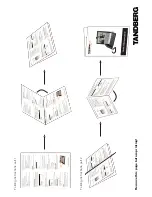
SNV-12 Operations Manual
5-8
5.11
Line Fault (Pilot Tone Fault/COR Fault) Detection
The CPM Module provides continuous line fault detection by monitoring receiver site
information from the SVM modules for proper operation. When a site is faulted, the SVM‟s
front panel FAULT LED is lit and the site will not be voted until the fault is cleared.
In applications using pilot tones, the CPM will disable a Site Voter Module if a set Fault Delay
time passes after the moment when the pilot tone disappears and before speech arrives. When
either speech or pilot tone again appears on that site's audio the fault will be cleared and the
CPM will automatically re-enable the failed site. The voter uses the absence of pilot tone as an
indication of an unsquelched receiver that is eligible for voting. Line fault detection removes
from voting consideration sites that have lost pilot tone due to a loss of link rather than because
the receiver has become unsquelched.
In applications using Hardwired COR rather than pilot tones, a site will be disabled if it has
continuous COR activity, but no speech is detected for the set time period. This prevents an
unsquelched receiver with no voice activity from tying up the system. In COR systems, if
voice activity is detected before the timer expires, the timer is reset to zero and starts running
again. If the timer runs out, the site will be faulted, the fault will not be cleared until speech is
again detected or COR is no longer present.
The fault delay time is the period between loss of COR and the non-appearance of speech. The
timer can be programmed to OFF, 5, 15, or 30 seconds. This selection is made on the CPM
module by switches SW2-5 and 6. This fault time will be the same for all modules in the
system, regardless of COR type, except for SVMs set to the “Unsquelched Receiver” COR
type, where COR is always active. The line fault timer will not be activated for these sites. For
all other COR types, the timer will start for each module as soon as the SVM‟s UNSQuelched
LED is lit (indicating COR or absence of Pilot Tone). The timer is also inactivated for any
SVM when it is locked on data; this prevents line faults during the transmission of long data
messages that do not contain speech (see Section 5.9).
5.12
Guard Tone Operation
Each SVM can also be set to use
Guard Tones,
alone or with pilot tones, for improved line
fault detection. A pilot tone is present on the line whenever the associated receiver is
squelched; the lack of a pilot tone should indicate the presence of a valid signal that could be
voted on. In some systems, poor line conditions cause intermittent pilot tone loss (for example,
a marginal microwave link). Guard tones can be used to remove these sites from consideration
for voting immediately upon loss of link, rather than after waiting for the line fault timer to
expire. When guard tone operation is enabled, a site is made ineligible for voting any time the
guard tone is continuously not present for 100 milliseconds after being acquired (a guard tone
is considered
acquired
when it has been detected, without interruption, for two seconds). The
site becomes eligible again as soon as guard tone is again detected. The SNV-12 automatically
notches the guard tone out of the received audio so it is neither heard by the console nor re-
transmitted. There are two standard pilot tone/guard tone frequency options: 2175 Hz and 1950
Hz. If guard tones and pilot tones are both enabled, one will use the 1950 Hz tone and the other
will use the 2175 Hz tone. The SVM will not begin guard tone operation until it first detects the
guard tone. See Section 3.12.6.3 for settings details.
Содержание SNV-12
Страница 12: ...SNV 12 Operations Manual 12 This page intentionally left blank ...
Страница 22: ......
Страница 32: ...SNV 12 Operations Manual 3 4 SNV 12 Figure 3 1 Outline Dimensions ...
Страница 75: ...SNV 12 Operations Manual 3 47 ...
Страница 113: ...SNV 12 Operations Manual 3 85 Figure 3 12 SVM 1 Remote Receiver Audio Input ...
Страница 120: ...SNV 12 Operations Manual 3 92 Figure 3 19 SVM 2 for Type I Signaling ...
Страница 121: ...SNV 12 Operations Manual 3 93 Figure 3 20 SVM 2 for Type II Signaling ...
Страница 122: ...SNV 12 Operations Manual 3 94 Figure 3 21 SVM 2 for Type III Signaling ...
Страница 123: ...SNV 12 Operations Manual 3 95 Figure 3 22 SVM 2 for Type V Signaling ...
Страница 125: ...SNV 12 Operations Manual 3 97 Figure 3 24 CIM 2 for Type II Signaling ...
Страница 126: ...SNV 12 Operations Manual 3 98 Figure 3 25 CIM 2 for Type III Signaling ...
Страница 127: ...SNV 12 Operations Manual 3 99 Figure 3 26 CIM 2 for Type V Signaling ...
Страница 130: ......
Страница 142: ...SNV 12 Operations Manual 4 12 End of Section 4 ...
Страница 145: ...SNV 12 Operations Manual 5 3 Figure 5 1 RX Audio Delay ...
Страница 172: ...SNV 12 Operations Manual 5 30 This page intentionally left blank ...
Страница 196: ...SNV 12 Operations Manual 6 24 This page intentionally left blank ...
Страница 202: ......
















































